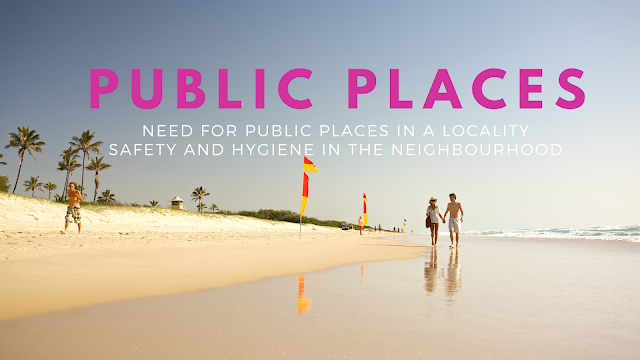"Neighbourhood! - Lesson plan and interactive activities to teach about public places and safety and hygiene in the neighbourhood"
Lesson: Public Places
Subject: Environmental Studies & English
Grade: Primary
Objectives:
- Students can know about neighbourhood.
- Students are able to know the need for Public Places in a locality.
- Students are able to know about recreational places.
- Students are able to know some rules to follow to be safe and hygienic in the nighbourhood.
- Students are able to know about adjectives.
Sameera lives with her family in a town. She is in grade 2. Sameera and her parents visit a lot of places around their house for various purposes every day. Let us know about them.
Activity: Think
Observe the below picture. Read the Sameera's tasks and drag the corresponding numbers in the picture.
Sameera's tasks
1. Sameera's mother wants to buy vegetables and fruits.
2. Sameera's father wants to deposit money.
3. Samera wants to go out for dinner with her family.
4. Sameera wants to spend her Sunday reading books.
5. Sameera wants to play with her friends in the evening.
6. Samera wants to send new year's wishes to her uncle.
7. Sameera's mother wants to buy new clothes.
8. Sameera's father takes her to the doctor for a check-up.
9. Sameera studies 2nd grade.
Activity: Read the story
"Sameera wants to visit their Grandpa's village Rajapuram. The village is near a blue sea. There are tall coconut trees. She likes to play with her friends under the coconut trees. Raju, Ali, and Rita are her friends. They are all neighbours. They visit a lot of places around their houses for various purposes every day. They play in green fields. "Neighbours are people who live next to each other or in the same building complex. A particular area where many families live is called a neighbourhood." She loves the village because the streets are very clean. Greenfields and pets are everywhere. There is a school, hospital, post office, railway station, and bank. The villagers are very friendly. They do different work. They keep their village clean and neat. She likes the village most."
Answer me:
1. What is a neighbourhood?
A. ____________________
Activity: Understand
Let us understand Public Places and need for the Public Places in a locality.
A public place is used by the people living in a nieighbourhood. School, hospital, bus stop, park, bank, post office, police station, airport, library, and market are some of the public places in a neighbourhood. People working in these places help us in our day-to-day lives.
Let us learn the names of some public places.
Read the names of the public places. And do practice with your friend.
Activity: Think Again
we have learned about public places and know some names of them. Now match the names of the places with their pictures. Check your understanding.
Activity: Think deep
Ali went to the railway station to receive his uncle. He saw many trains and people waiting to board their trains. There were a lot of shops. He also saw porters helping people carry their heavy luggage.
A railway station is a public place that people visit to travel from one place to another place. We look at many trains there. There are other public places that have different functions. Identify the things we can notice in the places. Match them.
Activity: Understanding
It is Sunday. Sameera and her friends are bored. Her grandfather suggests that they go to the beach. They go and enjoy themselves a lot. A beach is an example of a recreational place. People go to a recreational place for entertainment and spend their free time at leisure.
Think deep:
Unscramble the letters to find the names of recreational places.
Activity: Understand and think
Observe the below picture and share your responses.
People visit public places for various reasons. It is our duty to take care of public places because they are used by everyone. Every public place has its own set of rules to be followed. For instance, we are required to maintain silence when we visit a library to make sure we do not disturb others.
Here are some tips o follow to be safe and hygienic in the neighbourhood.
Public places are used by everyone in the nighbourhood. hence, it is important to keep them clean and be safe while using them.
Activity: Understand
Sameera likes to visit her grandpa's village. The village is small and beautiful. The streets are clean and neat. Villagers are very kind. Greenfields are everywhere. She has good friends. They play under the tall coconut trees.
Sameera has described the village as ' beautiful, small, clean, green, and neat.' These words tell us more about the village. 'Small refers to the village size. 'green refers to the colour of the village. "Beautiful tells us the village looks cool.
Words such as small, green, neat, beautiful, kind, good help us describe the village. These words are called describing words.
Describing words tell us more about naming words. Here beautiful and small describe the naming word village. Read the below post to know more about describing words/Adjectives.
Prepare a puppet of you or draw your picture and describe you.
Activity: Think deep
Sameera asks her grandfather to take her to the beach. It is very important to stay with an adult and listen to them when we visit such places. We may also meet strangers or lose our way sometimes, especially when we visit public places.
Think and complete the concept map.
Hope you enjoy the lesson.







Comments